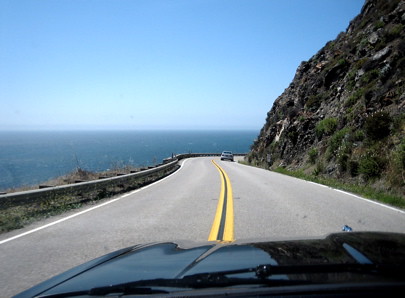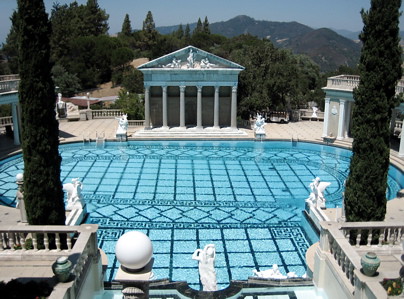
Driving the Pacific Coast Highway (please don’t ask how I got the photo).
OK, OK, I had no idea that my last piece of frippery about cowboys, horses and the Wld West would stir up so much interest, so I’ll post on these topics again in the near future.
But for now I want to say a bit more about the road trip up the California Pacific Coast Highway back in August before it fades from neuro-retention. If you are not familiar with Highway 1, it’s sufficient to say that it is one of the greatest coastal roads in the world. It runs from Southern California to San Francisco and has a backdrop of breathtakingly spectacular ocean scenery. The stretch south of Monterey known as "Big Sur" is simply magnificent and that whole region is quintessential California. If you ever get the chance to drive it don’t hesitate or you’ll miss out on one of the spectacular drives on the planet.
Half-way between posh Santa Barbara in the south and historic Monterey in the north lies San Simeon and the amazing Hearst Castle. Built by newspaper magnate, William Randolph Hearst between 1919 and 1947 on a 250,000 acre estate known as 'La Cuesta Encantada' ('The Enchanted Hill' if my O level Spanish is still holding up) is not only an astonishing feat of construction but an extraordinary collection of art treasures

Hearst Castle façade in the style of a Spanish cathedral by San Francisco architect, Julia Morgan.
It’s really quite astonishing what you can do when money is no object. Hearst made (and lost) a fortune or two in his lifetime. He pioneered jingoistic, sensationalist journalism (Rupert Murdoch paid close attention to this model) and agitated for the Spanish-American war. The principle character in Orson Welles’ film “Citizen Kane” was modeled on Hearst (I still haven’t figured out why it’s everybody’s favourite movie -it’s a miserable, charmless, flick IMHO). Throughout all this, Hearst continued to build the castle and fitted it out with an amazing art collection. The grounds were populated by exotic animals and The Ranch became the place to visit for the rich and famous. Film stars, politicians, adventurers, writiers, socialites and captains of industry were all to be seen at The Ranch (as Hearst liked to call it) during its heyday.

One of the pools at Hearst Castle. The parthenon-like structure was constructed with genuine Greco-Roman columns.
But all good things come to an end and following another financial reversal and then William Randolph’s death in 1951, the Hearst Corporation donated The Ranch to the State of California in 1957. Definitely the public’s gain. Perhaps George Bernard Shaw summed up the place the best when he said: "This is what God would have built if he had had the money."

Despite the fact that Hearst Castle is now in the public domain, the hoi polloi are not allowed in the pool!
No comments:
Post a Comment